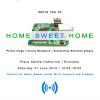Home Sweet Home
Home Sweet Home is the second event of HOME network, a project by Polina Zioga, multimedia visual artist and Kalina Ntampiza, architect engineer and industrial designer, in collaboration with Alexandros Nikolaos Ziogas, electrical and computer engineer.
As suggested by its title, the project is a portable, netless (without an internet connection) Wi-Fi network, a free access unlocked digital platform, carried by the artists and transmitting within the urban environment of various cities during a series of specific time periods and events. A portable, wireless router is used, the TP-Link TL-MR3020, running on an OpenWrt version, and controlled via a Linux-based environment. The router can be powered by a battery holder attached to its power supply USB cable, thus giving it the option to function independently and move in space while in use. The Wi-Fi router is not connected to the Internet, but rather functions as a wireless access point and a self-contained network which can be accessed by any mobile device or a device with a wireless adapter.
During the Home Sweet Home event, the network will be transmitting its signal from Place Sainte Catherine (Sint-Katelijneplein 1000 Brussel), on Saturday 21 June 2014 (hours to be announced). The visitors are invited to connect to the network with their devices (pc, laptops, mobiles, tablets etc.), engage, participate in and reflect on commonly shared experiences and contemporary questions regarding the notion of home and our sense of belonging in both the private and the public sphere.
Place Sainte Catherine was chosen not only as a significant and symbolic central space of the city, one of Brussels’ landmarks, but also as a space of conflict. The church, with the white façade and the almost black backside, is bound to be desecrated and turned into a covered market causing an ongoing debate between the citizens. A religious, cultural and historical reference of identity for the locals, a topos which produces a sense of belonging, and in this way a sense of home, seems to be at stake and also at conflict with the political state.
When the visitors connect to the network, they are redirected in a webpage, where they are enabled to interact with questions and images, derived from Where Am I at Home?, an intertext and work of video art by Polina Zioga, based on Agnes Heller’s original essay Where Are We at Home? (1995). The work implicates our sense of belonging in terms of space, time, our spiritual and cultural heritage, but also in terms of politics and the constitutional democracy.
More
information about the technical and theoretical framework of the project can be
found in:
Ntampiza,
Kalina, and Zioga, Polina (2014): The
Interconnected Object: Are You at Home in a Network?. In: Proceedings of 1st International Academic
Conference Places and Technologies 2014, 3-4 April 2014, Belgrade, Serbia:
936-943. ISBN 978-86-7924-114-6
Info
Date: June 2014
Last updated: June 2014



